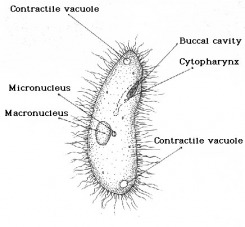General Paramecium Information

Paramecium putrinum (=P. trichium) is a slipper shaped ciliate which is found in oxygenated aquatic environments feeding near vegetative matter. This organism is quite common and may easily be obtained from the shallow waters of the Connecticut River. It is the smallest of the paramecia, attaining lengths of 70-140 um. Despite its small size and stout build it is the most agile of the paramecia, capable of bending back on itself and contorting in ways which mimic fluid, ameboid movement.
Paramecia are unicellular microorganisms belonging to the protoctist phylum Ciliophora. Members of this phylum (ciliates) are characterized by their external covering of continuously beating, hair-like cilia. Cilia are motility organelles homologous to the undulating tails of sperm cells and the epithelial cilia which line our respiratory tracts. These single celled organisms must perform all of the same functions as a multicellular organism without the luxury of labor division amongst specialized cells, and it is their ability to fulfill these requirements along with their elaborate ultrastructure which places them among the most functionally complex cells.
Ciliates are exceptional among the eukaryotes (nucleated cells) since they possess one macronucleus and at least one micronucleus, whereas most eukaryotes have just one DNA containing nucleus. The macronucleus participates in the day to day activities of growth and reproduction while the micronucleus remains relatively dormant until the cell undergoes some type of sexual process. (Sex and reproduction are distinct processes and most organisms do not require sexual recombination of genetic material prior to reproduction.) This nuclear dualism imparts a unique twist on the inheritance patterns of these organisms in addition to providing a distinguishing characteristic which can be used for identification. Careful attention must be paid to physical structures since paramecia have been classified based on their microscopic morphology rather than their sexual compatibility.
Viewed through a microscope, the micronucleus of P. putrinum can be seen seated next to the much larger macronucleus in the center of the cell. The buccal cavity, or oral region, is located toward the anterior of the cell. This orifice is lined with highly organized rows of beating cilia which draw food particles into the cytopharynx (equivalent to the throat of the cell) where they are incorporated into food vacuoles and digested. Also visible within the cytoplasm are two, large, sporadically contracting vacuoles at either end of the cell. The contraction of these vacuoles expels water from the cell as a means of balancing its salt concentration.
If the cell is disturbed, one can observe the discharge of the outer coating of trichocysts. These spine-like structures, analogous to nematocysts (the stinging cells of jellyfish), can fire out from the cell in a fraction of a second at the slightest physical or chemical stimulus. Discharged trichocysts may remain attached at their base; until they detach, the cell resembles a disheveled porcupine. The exact function of trichocysts is not known but it is thought they may be used for capturing prey.
Paramecia are a key link in detritus-based food webs in aquatic ecosystems. Most paramecia are bacteriovorous and feed voraciously on bacteria that accompany decaying organic matter. These bacteria-gorged cells are then consumed by other protists and small animals, which are in turn preyed upon by larger organisms.
Paramecium putrinum is a cosmopolitan organism and has been found in suitable habitats across the United States and Canada. Local distribution is aided by transportation in floodwaters, the wet fur of mammals and human activities. Global distribution of similar species is believed to be the result of the breakup of the supercontinent Pangea over 200 million years ago. This continent was home to ancestral paramecia that have subsequently been separated by continental drift. The oldest reported fossil Paramecium was discovered in a piece of amber dating back to the Cretaceous period, over 65 million years ago.
The paramecium, genus of protozoa of the phylum Ciliophora, is often called slipper animalcules because of their slipper-like shape. Paramecia are unicellular organisms usually less than 0.25 mm (0.01 in) in length and covered with minute hair-like projections called cilia. Cilia are used in locomotion and during feeding. When moving through the water, paramecia follow a spiral path while rotating on the long axis. When a paramecium encounters an obstacle, it exhibits the so-called avoidance reaction: It backs away at an angle and starts off in a new direction. Paramecia feed mostly on bacteria, which are driven into the gullet by the cilia. Two contractile vacuoles regulate osmotic pressure (see Osmosis) and also serve as excretory structures. A paramecium has a large nucleus called a macronucleus, without which it cannot survive, and one or two small nuclei called micronuclei, without which it cannot reproduce sexually. Reproduction is usually asexual by transverse binary fission, occasionally sexual by conjugation, and rarely by endomixis, a process involving total nuclear reorganization of individual organisms.
Paramecia abound in freshwater ponds throughout the world; one species lives in marine waters. They are easily cultivated in the laboratory by allowing vegetable matter to stand in water for a few days. The common species Paramecium caudatum is widely used in research.
